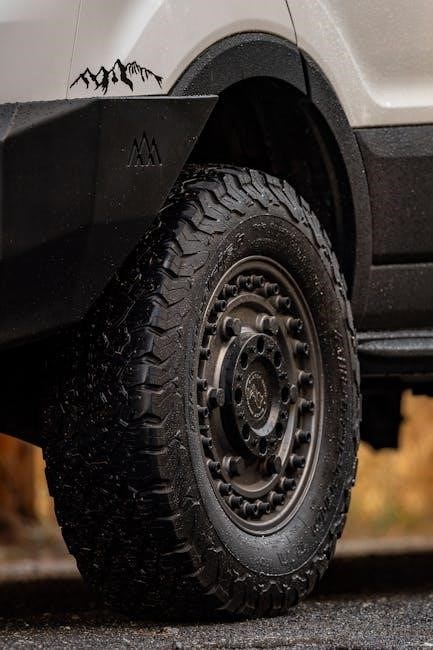ford truck parts interchange guide
Understanding Ford truck parts interchange is crucial for enthusiasts and mechanics, enabling cost-effective repairs and upgrades. It involves identifying compatible components across different models and years, ensuring proper fitment and functionality. This guide explores the essentials of interchange, helping you navigate compatibility, tools, and best practices for modifying or maintaining your Ford truck effectively.
1.1 Understanding the Basics of Parts Interchange
Parts interchange involves using components from one vehicle on another, provided they share compatibility. This practice saves costs and enhances customization. It requires understanding model-specific differences, such as engine types or axle ratios. Compatibility is key to ensuring proper fitment and functionality. Research and verification are essential to avoid installation issues and ensure safety.
1.2 Importance of Compatibility in Ford Trucks
Precise compatibility ensures Ford truck parts function seamlessly, preventing mechanical issues. Using VIN for accurate identification and online databases like Rockauto.com helps verify fitment. Attention to detail in part selection is crucial for safety and performance, aligning with proper installation procedures to maintain vehicle integrity.

Identifying Ford Truck Parts Using VIN
Using the Vehicle Identification Number (VIN) helps accurately identify Ford truck parts, ensuring compatibility and proper fitment. Online databases like Rockauto.com allow VIN-based searches for precise part matching.
2.1 Decoding the Vehicle Identification Number (VIN)
Decoding the Vehicle Identification Number (VIN) is essential for identifying Ford truck parts. The VIN is a 17-character code that provides details about the vehicle’s make, model, year, and specifications. Each position in the VIN represents specific information, such as engine type, transmission, and manufacturing plant. Online tools and Ford’s official resources can help decode the VIN, enabling accurate part identification and compatibility verification.
2.2 How VIN Affects Parts Compatibility
The Vehicle Identification Number (VIN) plays a critical role in determining parts compatibility for Ford trucks. By decoding the VIN, you can identify the specific engine, transmission, and axle configurations, ensuring that replacement or aftermarket parts are suitable for your vehicle. This precision minimizes fitment issues and guarantees optimal performance, making the VIN an indispensable tool for accurate parts selection and installation.
History of Ford Truck Platforms and Generations
Ford truck platforms have evolved significantly over the years, with each generation introducing new engineering advancements and design improvements. Understanding these changes helps in identifying compatible parts and upgrades, ensuring optimal performance and longevity for your vehicle;
3.1 Evolution of Ford Truck Models Over the Years
Ford truck models have undergone significant transformations since their inception, with each generation introducing innovative designs, enhanced performance, and improved functionality. From the early F-1 to the modern F-150, these trucks have evolved to meet changing consumer demands and technological advancements, offering greater durability, capability, and comfort. This evolution has shaped the trucks into the versatile vehicles we know today.
3.2 Key Differences Between Generations
Each Ford truck generation has distinct features, reflecting advancements in design, technology, and performance. Earlier models like the F-1 emphasized simplicity and durability, while modern F-150s incorporate advanced materials and eco-friendly engines. Differences in drivetrains, engine options, and axle setups highlight the evolutionary changes. These distinctions are crucial for understanding parts compatibility and ensuring proper interchange across various models and years.

Engine and Transmission Interchange
Engine and transmission interchange in Ford trucks offers flexibility for performance upgrades. Popular swaps include the 5.0L V8 and EcoBoost engines. Compatibility varies by model year and drivetrain setup, requiring careful matching of components. Always verify specifications to ensure smooth integration and optimal performance. Online databases and repair manuals are invaluable resources for successful swaps.
4.1 Common Engine Swaps for Ford Trucks
Popular engine swaps for Ford trucks include the 5.0L Coyote V8 and 6.7L Power Stroke diesel. These engines offer increased horsepower and torque, enhancing performance. Compatibility varies by model year, so ensuring proper mounting and wiring is essential. Online databases and forums provide detailed guides for enthusiasts. Always verify specifications for a seamless swap and optimal performance.
4.2 Transmission Compatibility Across Models
Transmission compatibility in Ford trucks depends on engine type and model year. Common transmissions like the 4R70W and 6R80 are often interchangeable across multiple Ford truck models. However, modifications may be required for proper fitment and functionality. Always verify specifications and ensure compatibility before swapping to avoid mechanical issues.
Axle and Differential Interchange
Ford truck axles and differentials vary by model and year, affecting compatibility. Ensure axle type, gear ratio, and vehicle weight match for proper fitment and performance.
5.1 Identifying Axle Types and Ratios
Identifying Ford truck axle types and ratios involves checking the vehicle’s specifications, VIN decoding, or consulting Ford’s documentation. Axle types vary (e.g., Dana, Ford 9-inch) and ratios determine gearing for performance or towing. Correct identification ensures proper fitment and functionality when swapping parts, avoiding potential damage or compromised performance. Always verify specs before installation.
5.2 Rear and Front Differential Compatibility
Ensuring rear and front differential compatibility is vital for optimal performance and safety. Compatibility depends on axle ratios, housing types, and gear configurations. Use VIN decoding or online databases to verify specs. Always inspect used parts for wear and ensure they match your Ford truck’s specific model and year for proper fitment and functionality. Incorrect installation can lead to drivetrain issues.

Brake and Suspension Interchange
Brake and suspension parts interchange requires careful consideration of compatibility. Factors like rotor size, caliper type, and spring rates must match your Ford truck’s specifications for safety and performance.
6.1 Brake System Components and Compatibility
Brake system compatibility is critical for safety and performance. Components like rotors, calipers, and brake pads must match your Ford truck’s specifications. Ensure proper fitment by verifying part numbers and sizes. Compatibility varies across models and years, so always consult manufacturer guidelines or databases. Correct installation ensures reliable braking and avoids potential hazards, making it essential to prioritize accurate part selection and professional installation if needed.
6.2 Suspension Upgrades and Interchangeable Parts
Suspension upgrades can enhance your Ford truck’s performance and durability. Components like springs, shocks, and control arms may be interchangeable across similar models, but compatibility varies by year and platform. Always consult factory specifications or aftermarket diagrams to ensure proper fitment. Modifications, such as lifting or lowering, require careful measurement to maintain alignment and prevent drivetrain issues, ensuring optimal performance and safety on and off the road.
Electrical and Electronic Systems
Ford truck electrical systems are complex, requiring precise compatibility when swapping parts. Modern vehicles rely on advanced ECUs and wiring harnesses, making proper integration essential for functionality and safety.
7.1 Wiring Harness and ECU Compatibility
Wiring harnesses and ECU compatibility are critical in Ford truck parts interchange. Modern systems rely on precise electrical connections, and mismatched components can cause malfunctions. Always verify part numbers and consult Ford’s official database or trusted sources like Rockauto to ensure compatibility. Proper integration is essential for maintaining functionality and avoiding electrical system errors.
7.2 Upgrading Electrical Components Safely
When upgrading electrical components in Ford trucks, ensure compatibility by consulting wiring diagrams and part numbers. Disconnect the battery before starting work to prevent shocks or short circuits. Use high-quality components and follow manufacturer guidelines. Test connections thoroughly post-installation. If unsure, seek professional assistance to avoid electrical system damage or safety hazards.
Finding and Verifying Parts
Use online databases to search for parts by number, ensuring compatibility with your Ford truck model. Verify each part’s fitment and specifications before purchase.
8.1 Using Online Databases for Parts Lookup
Online databases like Rockauto.com and AutoZone.com allow you to search for Ford truck parts by VIN or part number. Enter the part number in the search bar to find compatible options. Websites often provide detailed specifications and images to ensure accuracy. Use the VIN decoder tool to confirm fitment for your specific Ford truck model, ensuring the part matches your vehicle’s requirements precisely.
8.2 Tips for Inspecting Used Parts
When inspecting used Ford truck parts, check for wear, corrosion, and damage. Look for signs of leaks, dents, or excessive mileage. Verify functionality by testing electrical components and ensuring moving parts operate smoothly. Compare the part to the original to confirm compatibility. Use online resources or consult with experts to ensure the part is suitable for your Ford truck’s make and model year.
Tools and Equipment Needed
Essential tools include wrenches, screwdrivers, and specialized equipment like OBD-II scanners. Ensure safety with gloves and jack stands. Proper tools enhance efficiency and safety during parts installation.
9.1 Essential Tools for Parts Swapping
A socket set, wrenches, screwdrivers, and pliers are fundamental. A jack and jack stands ensure safe lifting, while an impact wrench simplifies bolt removal. An OBD-II scanner helps diagnose issues, and a torque wrench ensures proper tightening. Specialized tools like axle pullers or transmission jacks may be needed for specific swaps. Always maintain tools in good condition for reliability and safety.
9.2 Safety Precautions During Installation
Always wear protective gear like gloves and safety glasses. Ensure the vehicle is on level ground and securely supported by jack stands. Disconnect the battery to prevent electrical hazards. Work in a well-ventilated area, especially when handling chemicals. Follow manufacturer guidelines for torque specifications and proper installation procedures. Never improvise with tools or methods to avoid accidents or damage.

Common Issues and Solutions
Addressing fitment problems and compatibility conflicts is key. Troubleshooting involves checking VIN accuracy, verifying part numbers, and consulting manuals. Solutions may include upgrading components or seeking expert advice to ensure proper installation and functionality, preventing future issues and ensuring safety on the road.
10.1 Troubleshooting Fitment Problems
Troubleshooting fitment issues begins with verifying part compatibility using the VIN and manufacturer specs. Common problems include incorrect part numbers, electrical mismatches, or outdated components. Cross-referencing with catalogs like RockAuto or consulting forums can help resolve errors. Additionally, inspecting for physical damage or wear during installation is crucial to ensure proper fitment and functionality, preventing further complications down the road.
10.2 Addressing Compatibility Conflicts
Compatibility conflicts often arise from mismatches in electrical systems, axle ratios, or engine-transmission pairings. Upgrading wiring harnesses or ECUs can resolve electronic issues, while swapping to compatible axles ensures proper drivetrain performance. Consulting expert forums or Ford-specific communities provides tailored solutions, minimizing downtime and ensuring seamless integration of interchange parts for optimal functionality and reliability in your Ford truck.
Resources and Communities
Online databases like Autozone and RockAuto offer detailed parts lookup tools. Forums and communities, such as Ford Truck Enthusiasts, provide expert advice and solutions for interchange challenges.
11.1 Recommended Forums and Websites
Forums like Ford Truck Enthusiasts and websites such as Autozone and RockAuto are invaluable for parts interchange guidance. They offer detailed part databases, swap tutorials, and expert advice. YouTube channels dedicated to Ford truck modifications also provide visual guides for complex swaps. These resources help enthusiasts and mechanics navigate compatibility challenges and ensure successful upgrades or repairs.
11.2 Consulting with Experts and Enthusiasts
Engaging with Ford truck experts and enthusiasts through forums and communities can provide invaluable insights. Experienced mechanics and avid Ford fans often share detailed knowledge on parts compatibility and installation tips. YouTube channels and specialized Facebook groups are excellent platforms for seeking personalized advice. Building relationships within these communities fosters trust and ensures reliable guidance for your Ford truck projects.
